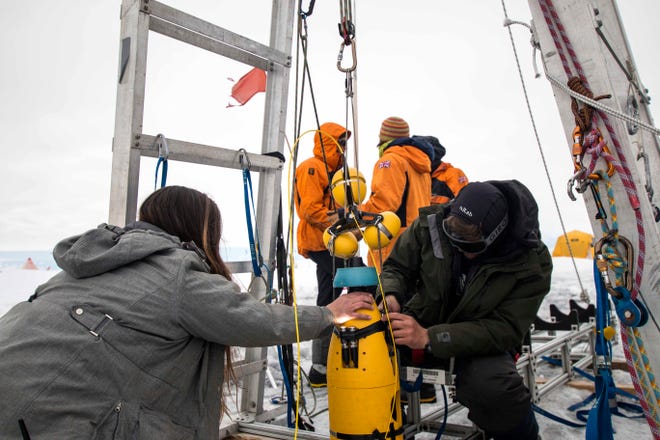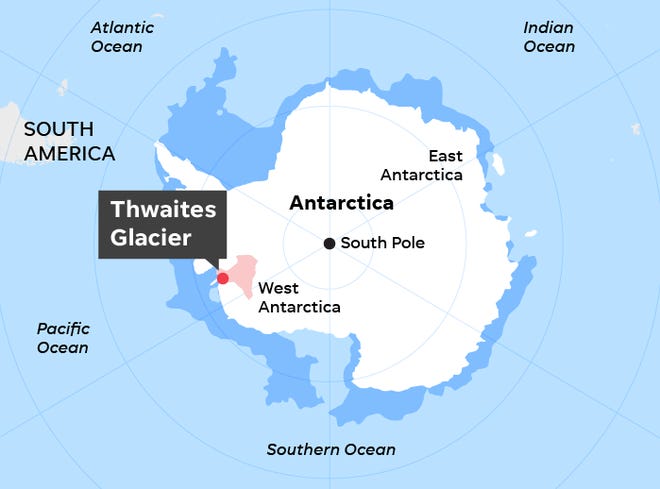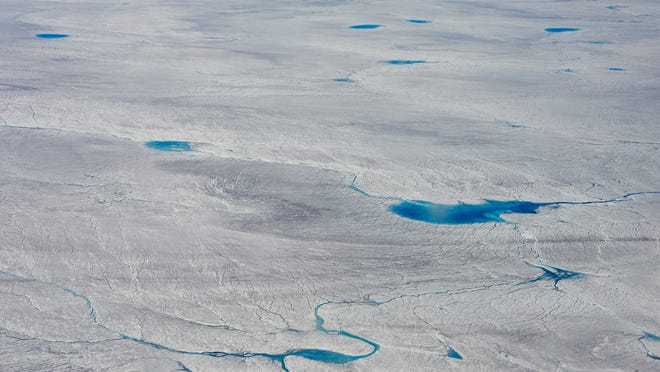[ad_1]
Antarctica’s Thwaites glacier, also known as the “Doomsday Glacier” because of its potential to drive alarming sea level rise, isn’t melting at a pace as fast as feared – but deep fractures in ice are taking the heaviest toll, according to new research.
The research, published in two studies Wednesday in the journal Nature, concludes that Thwaites’ retreat appears to be driven by different processes beneath its floating ice shelf – which holds the glacier in place – than previously understood.
The melting beneath much of the ice shelf is slower than expected, but melting in crevasses and cracks is much more rapid.
“Our results are a surprise, but the glacier is still in trouble,” British Antarctic Survey oceanographer Peter Davis, lead author of one of the Nature papers, said in a New York University press release following the research’s publication.
“What we have found is that despite small amounts of melting there is still rapid glacier retreat, so it seems that it doesn’t take a lot to push the glacier out of balance,” Davis added.
Graphics:Antarctic ‘Doomsday glacier’ hanging on ‘by its fingernails,’ study says. How it’s melting.
2020:Warm water discovered beneath Antarctica’s ‘doomsday’ glacier, scientists say
The warming of the ocean driven by climate change threatens Antarctica’s Thwaites, as warmer water melts the bottom of the Florida-sized glacier, particularly its most vulnerable areas.
“We see crevasses, and probably terraces, across warming glaciers like Thwaites,” Cornell University Earth scientist Britney Schmidt, also a lead author of one of the studies, stated in NYU’s release. “Warm water is getting into the cracks, helping wear down the glacier at its weakest points.”
Robot helps discovery
A 13-foot robot swimming under the sea, Icefin, allowed scientists to examine a hard-to-reach area beneath Thwaites and look at what’s eating away at the glacier.
The researchers noted the fracturing of the ice takes the greatest toll on the glacier, even more than melting.
“That’s how the glacier is falling apart. It’s not thinning and going away. It shatters,” Schmidt told The Associated Press.
That fracturing “potentially accelerates the overall demise of that ice shelf,” added Paul Cutler, the Thwaites program director for the National Science Foundation who returned from the ice last week.

Why is Thwaites glacier important?
Some scientists see Thwaites as the most vulnerable and most significant glacier in the world in terms of future global sea-level rise.
Over recent decades, the amount of ice flowing out of Thwaites and its neighboring glaciers has nearly doubled. Ice draining from Thwaites into the Amundsen Sea already accounts for about 4% of global sea-level rise.

A runaway collapse of the glacier could lead to a significant increase in sea levels of more than two feet – which would be enough to devastate coastal communities worldwide, according to CNN. Although that could take hundreds of years, the ice shelf could fall apart much sooner.
More:Collapse of Florida-sized glacier may happen soon, raising sea levels and threatening coastal cities
In 2021, scientists found that the glacier’s eastern ice shelf had cracks rapidly accelerating – and could see the ice shelf shatter within the next five years.
Contributing: The Associated Press. Doyle Rice, USA TODAY.

[ad_2]
Source link
